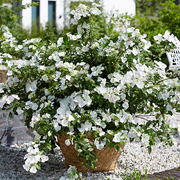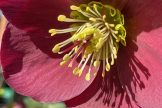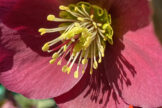Hydrangea flowers are produced from early spring to late autumn; they grow in flowerheads (corymbs or panicles) most often at the ends of the stems. Typically the flowerheads contain two types of flowers: small non-showy flowers in the center or interior of the flowerhead, and large, showy flowers with large colorful sepals (tepals). These showy flowers are often extended in a ring, or to the exterior of the small flowers. In most species, the flowers are white, but in others (notably H. macrophylla), can be blue, red, pink, light purple, or dark purple. In these species, floral color change occurs due to the presence of aluminum ions which are available or tied up depending upon the soil pH.
 Out in the nursery we’ve been enjoying a new Hydrangea which is holding its foliage far longer than all others. Hydrangea ‘Runaway Bride’ is exceptional also for its flowering; along the stems at every leaf pair in the garland style, as well as at the tips- meaning it doesn’t need to be pruned. Basically – it gets covered in clear white flowers which last upwards of two months. Bred from wild Hydrangeas in Japan it’s a gorgeous feature plant with deep red through orange to yellow autumn foliage, suitable for pots, baskets and garden beds.
Out in the nursery we’ve been enjoying a new Hydrangea which is holding its foliage far longer than all others. Hydrangea ‘Runaway Bride’ is exceptional also for its flowering; along the stems at every leaf pair in the garland style, as well as at the tips- meaning it doesn’t need to be pruned. Basically – it gets covered in clear white flowers which last upwards of two months. Bred from wild Hydrangeas in Japan it’s a gorgeous feature plant with deep red through orange to yellow autumn foliage, suitable for pots, baskets and garden beds.
Why is it called Runaway Bride? We’ve no idea.
Pruning your Hydrangeas
Sharpen your secateurs and get stuck into one of the most rewarding shrubs to prune. Few shrubs respond as positively to pruning as hydrangeas; old woody and diseased hydrangeas turn into vigorous healthy flowering shrubs after a good rejuvenating prune.
Shrub hydrangeas can be divided into two groups for pruning purposes:
1. Hydrangeas that flower on current year’s growth
2. Hydrangeas that flower on last year’s growth
Group 1 hydrangeas include Pee Gee Hydrangea (H. paniculata Grandiflora) and Smooth Hydrangea (H. aborescens ‘Annabelle’ or ‘Grandiflora’). These are the easiest to prune, as you can just cut them back hard to a strong pair of healthy buds in late winter and they will jump away in spring, happily flowering on their new growth. These can be pruned down to around 25cm. If you are in a very cold region, wait until early spring.
Group 2 hydrangeas include Mophead and Lacecap Hydrangeas (Hydrangea macrophylla), Oakleaf Hydrangeas (H. quercifolia) and Tea of Heaven or Mountain Hydrangeas (H. serrata). These require a bit more thought in their pruning, but it is easy enough once you understand what is going on. If a stem has already flowered (you can see the dead flower, or a clear cut where it was cut off), then cut it back hard to a pair of buds (often small and dark), this will grow into a good vegetative shoot which will flower the following year. If a stem has not flowered, then it will flower this coming season and so just cut back lightly to a pair of nice fat buds. Then tidy up by snipping out any very thin, shabby or twiggy growth. It is that easy. In spring, when you are cutting flowers – cut long stems back to a pair of buds, with luck you will get nice growth that will turn into flowering wood for the following year.
Rejuvenating old hydrangeas
Those giant old mopheads you see that haven’t been pruned in years, can be rejuvenated in a single effective pruning session over winter. A pruning saw is small enough to slide in at the base. Cut away the old dark woody non-productive material, leaving the fresher new growth. Then use secateurs to trim away any thin wispy branches leaving good sturdy branches. These can be lightly cut back to the big fat buds which will turn into flowering growth. Fresh vegetative growth will come from the base which will become flowering stems the following year.











